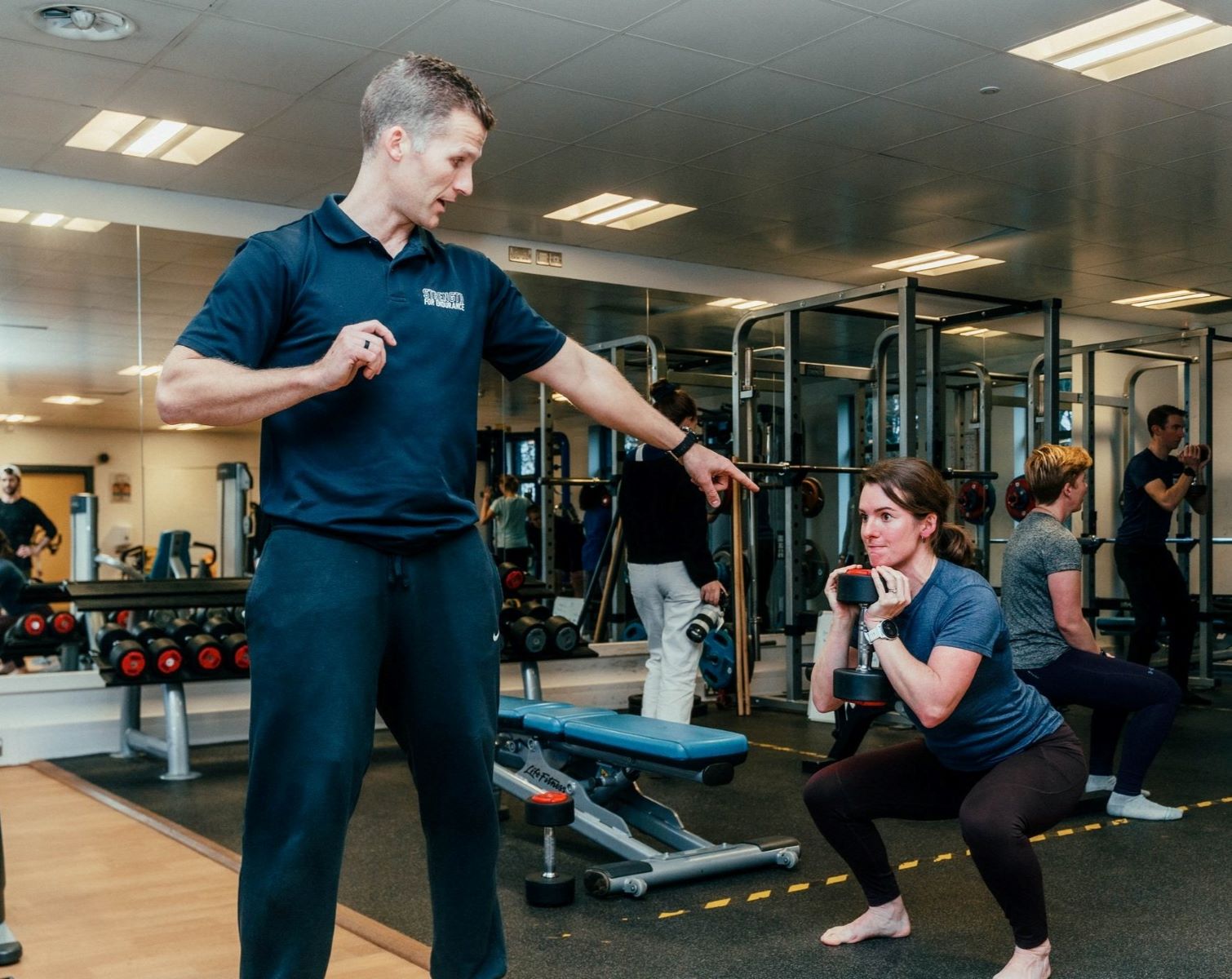Home>Misc>Featured>What Is The Recommended Duration For A Session Of Cardiorespiratory Endurance Exercise?


Featured
What Is The Recommended Duration For A Session Of Cardiorespiratory Endurance Exercise?
Modified: August 21, 2023
Find out the recommended duration for a session of cardiorespiratory endurance exercise in this featured article. Enhance your fitness routine with expert advice!
Introduction
Cardiorespiratory endurance exercise, also known as aerobic exercise, is a crucial component of a well-rounded fitness routine. It involves activities that elevate your heart rate and increase your breathing rate for an extended period of time. Regular cardiorespiratory endurance exercise helps improve the efficiency of your cardiovascular system, enhances lung capacity, and boosts overall endurance.
The duration of a cardiorespiratory endurance exercise session is an important consideration for optimizing its effectiveness. It is crucial to find the right balance between pushing your limits and avoiding overexertion. The recommended duration of a cardiorespiratory endurance exercise session depends on various factors such as your fitness level, goals, and any pre-existing health conditions.
In this article, we will explore the factors influencing the duration of cardiorespiratory endurance exercise sessions and provide recommendations to ensure that you reap the maximum benefits while minimizing the risks.
Whether you are a beginner starting your fitness journey or an experienced athlete looking to level up, understanding the guidelines for the recommended duration of cardiorespiratory endurance exercise sessions is essential.
Let’s dive deeper into the world of cardiorespiratory endurance exercise and discover how to optimize your workouts for maximum results.
Understanding Cardiorespiratory Endurance Exercise
Cardiorespiratory endurance exercise is a type of physical activity that primarily targets the cardiovascular and respiratory systems. It involves engaging in continuous, rhythmic movements that elevate your heart rate and increase the demand for oxygen in your body. Common examples of cardiorespiratory endurance exercises include running, swimming, cycling, and brisk walking.
During cardiorespiratory endurance exercise, your heart pumps more blood, delivering oxygen and nutrients to your muscles. Simultaneously, your breathing rate increases to supply oxygen to the working muscles and eliminate waste products, such as carbon dioxide.
Regular cardiorespiratory endurance exercise offers numerous benefits, both physically and mentally. It helps improve heart and lung health, enhances overall endurance, increases energy levels, and aids in weight management. Additionally, engaging in cardiorespiratory endurance exercise releases endorphins, which are known as “feel-good” hormones, promoting a positive mood and reducing stress levels.
It is important to note that the intensity of cardiorespiratory endurance exercise plays a significant role in its effectiveness. The intensity level can be measured using indicators such as heart rate or perceived exertion. High-intensity workouts, such as sprinting or interval training, can provide a greater challenge to the cardiovascular system, while low to moderate-intensity exercises offer a more sustainable and longer duration approach.
Now that we have a basic understanding of cardiorespiratory endurance exercise, let’s explore the factors that influence the duration of these exercise sessions to ensure safe and effective workouts.
Factors Influencing the Duration of Cardiorespiratory Endurance Exercise Sessions
Several factors come into play when determining the appropriate duration for cardiorespiratory endurance exercise sessions. These factors can vary from person to person and should be taken into consideration to design a workout plan that suits your individual needs and goals.
1. Fitness Level: Your current fitness level is a crucial factor in determining the duration of your cardiorespiratory endurance exercise sessions. Beginners might start with shorter durations and gradually increase as their fitness improves, while seasoned athletes may be able to handle longer durations without risking overexertion.
2. Goals: The goals you have set for your cardiorespiratory endurance exercise can influence the duration of your sessions. For general fitness and health maintenance, shorter sessions may be sufficient. However, if your goal is to improve endurance or train for a specific event, longer sessions may be required to challenge and push your limits.
3. Time Availability: Your available time to dedicate to cardiorespiratory endurance exercise can impact the duration of your sessions. If you have limited time, shorter, high-intensity workouts like interval training can be an effective option. On the other hand, if you have more time to spare, longer steady-state workouts can be incorporated into your routine.
4. Training Frequency: The frequency at which you engage in cardiorespiratory endurance exercise plays a role in determining the duration of each session. If you are working out multiple times per week, shorter sessions may be more appropriate to allow for recovery and prevent overexertion. Conversely, if you have fewer sessions per week, longer sessions may be necessary to reach your fitness goals.
5. Individual Tolerance: Each person’s body responds differently to exercise. It is important to listen to your body and determine your individual tolerance. Some individuals may thrive with longer sessions, while others may find shorter sessions more suitable.
It’s worth mentioning that these factors are not definitive rules, but rather guidelines to help you customize your cardiorespiratory endurance exercise program. Consulting with a fitness professional can provide valuable insight and help you design a program tailored to your specific needs.
Recommendations for the Duration of Cardiorespiratory Endurance Exercise Sessions
When it comes to determining the ideal duration of cardiorespiratory endurance exercise sessions, it is important to strike a balance between sufficient stimuli for improvement and avoiding excessive strain on the body. Here are some general recommendations to consider:
1. Beginners: If you are new to cardiorespiratory endurance exercise, start with shorter sessions of around 20-30 minutes, three to four times a week. As your fitness level improves, gradually increase the duration by 5-10 minutes per session until you reach a target duration of 45-60 minutes.
2. Moderate Fitness Level: If you have been regularly engaging in cardiorespiratory endurance exercise and have a moderate fitness level, aim for sessions lasting 30-45 minutes, four to five times per week. This duration allows for sufficient aerobic conditioning and strengthens endurance.
3. Advanced Fitness Level: Individuals with a high level of fitness and training experience can consider longer sessions of 45-60 minutes or more, four to six times per week. This duration challenges the cardiovascular system, enhances endurance, and promotes further improvements.
4. High-Intensity Interval Training (HIIT): HIIT workouts involve alternating short bursts of high-intensity exercise with periods of rest or low-intensity exercise. These sessions typically last 20-30 minutes, including warm-up and cool-down. The intense nature of HIIT allows for a shorter duration while still achieving significant cardiovascular benefits.
Remember, these are general recommendations, and individual preferences and goals may vary. It is important to listen to your body and adjust the duration based on your comfort, fitness level, and personal goals.
Additionally, it is essential to include proper warm-up and cool-down periods in your cardiorespiratory endurance exercise sessions. This helps prepare your body for the workout and aids in the recovery process, reducing the risk of injury.
Overall, the key is finding a duration that allows you to perform the exercise comfortably and maintain the desired intensity throughout the session. Strive for consistency and gradually increase the duration over time to challenge yourself and continue progressing.
Benefits of Following Recommended Duration Guidelines
Following the recommended duration guidelines for cardiorespiratory endurance exercise sessions comes with a multitude of benefits. Let’s take a look at some of the advantages:
1. Improved Cardiovascular Health: Engaging in cardiorespiratory endurance exercise for the recommended duration strengthens your heart, improves blood circulation, and enhances the efficiency of your cardiovascular system. This reduces the risk of cardiovascular diseases such as heart attacks, strokes, and high blood pressure.
2. Increased Endurance: Longer duration workouts challenge your aerobic capacity, allowing your body to adapt and improve its endurance levels over time. Regularly following the recommended duration guidelines will help you build stamina, enabling you to sustain physical activity for longer periods without feeling fatigued.
3. Enhanced Weight Management: Cardiorespiratory endurance exercise is an effective way to burn calories and support weight management. By adhering to the recommended duration, you can maximize the calorie expenditure during each session, aiding in weight loss or weight maintenance goals.
4. Improved Mood and Mental Well-being: Engaging in cardiorespiratory endurance exercise releases endorphins, which are known as “feel-good” chemicals. Following the recommended duration guidelines allows you to experience these mood-boosting benefits, reducing stress, anxiety, and symptoms of depression.
5. Increased Energy Levels: Regular cardiorespiratory endurance exercise for the recommended duration helps improve your overall energy levels. It boosts oxygen and nutrient delivery to your muscles and organs, improving their efficiency and reducing the feeling of fatigue in everyday activities.
6. Better Sleep Quality: Engaging in cardiorespiratory endurance exercise for the recommended duration can positively impact your sleep. It helps regulate your sleep-wake cycle, promotes deeper, more restorative sleep, and reduces the likelihood of sleep disturbances.
7. Overall Health and Longevity: By following the recommended duration guidelines, you are prioritizing your health and longevity. Regular cardiorespiratory endurance exercise has been linked to a reduced risk of chronic diseases such as diabetes, certain types of cancer, and age-related cognitive decline.
It is important to note that these benefits are not achieved overnight. Consistency and adherence to the recommended duration guidelines are key factors in reaping the rewards of cardiorespiratory endurance exercise for your overall well-being.
Now that we understand the benefits of following the recommended duration guidelines, let’s explore the potential risks of exceeding or insufficiently meeting these guidelines.
Risks of Exceeding or Insufficient Duration of Cardiorespiratory Endurance Exercise Sessions
While cardiorespiratory endurance exercise is highly beneficial for overall health, it is crucial to be mindful of the risks that can arise from exceeding or insufficiently meeting the recommended duration guidelines. Let’s explore these risks:
1. Overexertion and Increased Injury Risk: Exceeding the recommended duration of cardiorespiratory endurance exercise can lead to overexertion, increasing the risk of injury. Pushing beyond your physical limits without allowing adequate recovery time can strain your muscles, joints, and ligaments, potentially resulting in overuse injuries such as stress fractures, sprains, or strains.
2. Burnout and Mental Fatigue: Extended duration workouts may lead to burnout and mental fatigue. If you consistently push yourself beyond what your body can handle, you may become demotivated, experience a loss of interest in exercise, or even develop symptoms of physical and mental exhaustion.
3. Decreased Immune Function: Prolonged, intense cardiorespiratory endurance exercise can temporarily suppress the immune system, increasing susceptibility to illness and infection. Overtraining and insufficient recovery time can compromise the body’s ability to fend off viruses and bacteria.
4. Neglected Strength Training and Flexibility: Spending too much time on cardiorespiratory endurance exercise sessions may lead to neglecting other important aspects of fitness, such as strength training and flexibility. These components are crucial for maintaining muscular balance, joint stability, and overall physical functionality.
On the other hand, insufficiently meeting the recommended duration guidelines for cardiorespiratory endurance exercise can result in:
1. Limited Cardiovascular Benefits: Not meeting the recommended duration means you may not achieve optimal cardiovascular adaptations. Your heart and lungs may not receive enough sustained stimulation to improve their efficiency and capacity.
2. Reduced Calorie Burn: Shorter durations may result in fewer calories burned during the exercise session, potentially hindering weight management goals.
3. Limited Endurance Development: Insufficient duration may limit your ability to challenge and improve your endurance levels, making it harder to achieve increased stamina and performance.
It is important to strike a balance and find the right duration that aligns with your fitness level, goals, and overall well-being. Individualize your approach, listen to your body, and seek guidance from a fitness professional to avoid the risks associated with exceeding or insufficiently meeting the recommended duration guidelines.
Now that we understand the potential risks, let’s explore some tips for designing an effective cardiorespiratory endurance exercise program.
Tips for Designing an Effective Cardiorespiratory Endurance Exercise Program
To ensure that your cardiorespiratory endurance exercise program is effective and safe, consider these tips when designing your workouts:
1. Set Clear Goals: Determine your specific goals for cardiorespiratory endurance. Whether it’s improving overall fitness, preparing for an event, or managing weight, knowing your goals will help you tailor your program accordingly.
2. Gradually Increase Duration: Start with shorter durations and gradually increase the length of your cardiorespiratory endurance exercise sessions. This allows your body to adapt and minimizes the risk of overexertion or injury.
3. Mix Up Intensity Levels: Incorporate a mix of high-intensity, moderate-intensity, and low-intensity sessions. This variety challenges different energy systems and provides a well-rounded training stimulus.
4. Include Variety of Activities: Incorporate a variety of cardiorespiratory endurance exercises to engage different muscle groups and reduce the risk of overuse injuries. This can include activities such as running, cycling, swimming, hiking, or group fitness classes.
5. Use Interval Training: Incorporate interval training to challenge your cardiovascular system and build speed and endurance. Alternate between periods of high intensity and active recovery to maximize calorie burn and improve overall fitness.
6. Prioritize Recovery: Allow for adequate recovery time between sessions to avoid overtraining and enhance overall performance. Incorporate rest days and active recovery activities such as light stretching or yoga.
7. Monitor Intensity: Use heart rate monitoring or the perceived exertion scale to monitor and adjust the intensity of your cardiorespiratory endurance exercise. This will help ensure that you are working at the appropriate level for your goals.
8. Proper Warm-up and Cool-down: Always include a proper warm-up and cool-down period in your cardiorespiratory endurance exercise sessions. This prepares your body for the workout and helps prevent injuries.
9. Seek Professional Guidance: If you are new to cardiorespiratory endurance exercise or have specific health considerations, it is recommended to seek guidance from a qualified fitness professional who can help design a program tailored to your needs.
Remember, consistency and proper technique are key to achieving your desired results. Monitor your progress, listen to your body, and make adjustments as necessary to ensure an effective and enjoyable cardiorespiratory endurance exercise program.
Now that we have explored the tips for designing an effective program, let’s wrap up our discussion on cardiorespiratory endurance exercise.
Conclusion
Cardiorespiratory endurance exercise is a vital component of a well-rounded fitness routine. By understanding the recommended duration guidelines and customizing your workouts based on your fitness level, goals, and individual needs, you can maximize the benefits of these exercise sessions while minimizing the risks.
Remember, the duration of cardiorespiratory endurance exercise sessions should be gradually increased as your fitness improves, taking into account factors such as intensity, frequency, and individual tolerance. It is crucial to find a balance that challenges your body without pushing it into overexertion.
Following the recommended duration guidelines offers numerous benefits, such as improved cardiovascular health, increased endurance, better weight management, enhanced mood, and overall well-being. Additionally, it is important to be aware of the potential risks associated with exceeding or insufficiently meeting these guidelines, such as overexertion, injury, burnout, and limited progress.
Designing an effective cardiorespiratory endurance exercise program involves setting clear goals, gradually increasing duration, incorporating variety, monitoring intensity, and prioritizing recovery. By following these tips and seeking guidance from a fitness professional when needed, you can design a program that aligns with your goals and ensures long-term success.
Remember, consistency is key. Establish a routine that works for you and enjoy the journey of improving your cardiovascular fitness, endurance, and overall health. Embrace the challenges, listen to your body, and celebrate your progress along the way.
So lace up your shoes, dive into the world of cardiorespiratory endurance exercise, and experience the incredible benefits it has to offer. Your body and mind will thank you for it.









